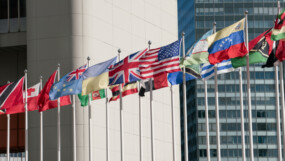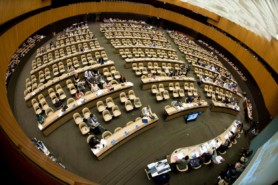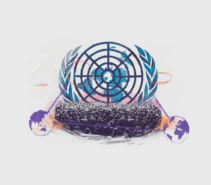Posted on 12 Mar 2018
On 5 February, the ‘Zero Draft‘ of the Global Compact for Safe, Orderly and Regular Migration* was released by co-facilitators Mexico and Switzerland. The draft, which reflects the views of member states, UN agencies, civil society and academia expressed during extensive consultations in 2017, sets out 22 core objectives with a view to meeting a single aim – making migration work for all. The content of the draft now forms the basis for nine months of formal intergovernmental negotiations. The hope? That by December 2018, states formally adopt the Global Compact.
The reactions to the Zero Draft have been mixed. One can detect the usual lethargy and cynicism that accompany cumbersome international processes that result in non-binding, non-normative frameworks. Others have criticized the draft for essentially repackaging existing ideas and presenting current tools as being capable of combating problems that arguably would be alleviated if these tools were fit for purpose, or if the necessary resources and political will had been dedicated to their proper implementation.
But, while there is certainly an element of truth to these criticisms, the overall tone of the document, which is ambitious and defiant, merits some praise. After the withdrawal of the US from the process and resounding EU sentiments that the UN is biased towards a positive view of migration there was the risk that the document would be overly conservative. Instead, many of the core objectives, and the language in which they are couched, contain politically unpalatable yet pertinent points raised by experts, and humanitarian and development practitioners.
The Global Initiative Against Transnational Organized Crime was one of the expert organizations called upon during the six 2017 informal thematic sessions to gather substantive input and concrete recommendations. The GI was a panelist during session five (‘Smuggling of migrants, trafficking in persons and contemporary forms of slavery’). Aligning with recommendations made by the GI, the Zero Draft now includes as one of its core commitments Objective 9: To strengthen the transnational response to smuggling of migrants.
Objective 9: Strengthen the transnational response to smuggling of migrants
Objective 9 has three goals: preventing smuggling, ensuring smuggled migrants are not criminalized and ending impunity for smuggling networks. The methods suggested to achieve these goals range from the traditional – compelling states to ratify UNTOC – to the more innovative – i.e. institutionalizing transnational mechanisms for intelligence sharing.
The GI welcomes several positive elements that are apparent in Objective 9, namely the implicit acknowledgment that migrant smuggling and human trafficking are distinct crimes requiring separate policy and practical responses; the need to prioritize responses to situations of smuggling under aggravated circumstances; and the reiteration that smuggled migrants should not be criminalized.
Of some concern, however, is the goal of ending the impunity of smuggling networks. There is a lack of nuance in this goal: it echoes the traditional perspective that all smuggling is inherently exploitative, illicit behaviour. It fails to appreciate that migrant smuggling exists on a spectrum – from very low-level, limited or non-profit activities to highly orchestrated, violent and lucrative criminal groups extorting and exploiting migrants. This goal therefore runs the risk of perpetuating the pursuit of any perpetrator embroiled in smuggling, when it should instead be rallying for a collective commitment by law-enforcement bodies to prioritize the investigation of those who facilitate the worst forms of smuggling.
To disrupt smuggling networks effectively and end the impunity of actors within them, the GI believes the Zero Draft should provide clearer direction to states and law-enforcement bodies on the need to prioritize counter-smuggling efforts. In particular, the GI suggests that law-enforcement bodies target those groups that
- have the infrastructure and capacity to move large numbers of people en masse;
- use the profits from smuggling in harmful ways (e.g. to perpetrate violence, conflict or terrorism); and
- enact the greatest levels of abuse or exploitation against the people they move.
What is disappointing about Objective 9 is that it fails to acknowledge that refugees and migrants do not simply ‘feel compelled to resort to smugglers’, but they are forced to rely upon smugglers in the absence of any viable alternative. When the pressure or desire to move exists – and there are no opportunities to do so safely or legally – then smuggling is many people’s only option.
Fundamentally, the solution to preventing smuggling is the existence or creation of safe and legal routes to countries of destination, and freedom of movement and trade in the regions of source and transit. Until this is accepted, we risk crafting more creative yet ineffective policies in the Global Compact designed to overcome these deficiencies.
* The Global Compact for Migration is one of two non-legally binding documents that countries committed to create in the 2016 New York Declaration.



